Two and a half years and over 300,000 downloads in, we have shared more than 140 VBAC stories on The VBAC Link Podcast.
We’ve gone from, “Hey! We should start a Podcast,” to an alive and thriving weekly episode full of VBAC-related facts and information. Reflecting on how far we have come from, it has been quite a journey!
Sharing VBAC success stories was our initial focus, but we soon realized that we needed to share ALL the stories, not just the happy ones that end in a vaginal birth. Along with VBAC birth stories, we have shared CBAC (Cesarean Birth After Cesarean) after TOLAC stories, uterine rupture stories, and even really tough VBAC experiences.
Each story is as unique as the person telling it. Each story contains valuable information you can use to prepare for your VBAC or support TOLAC families. Or, if you are just a birth nerd that loves pregnancy and babies, you will find plenty of fascinating stories!

Below I have selected a wide variety of episodes that cover various birth outcomes and topics so make sure to read through them all, click the links for more information on our blog, and listen to the shows that resonate with you the most!
To get weekly VBAC stories, make sure to subscribe on Apple Podcasts, Google Podcasts, Spotify, Amazon Music/Alexa, or wherever you listen to podcasts.
Meagan’s VBA2C (Vaginal Birth After Two Cesareans) at a Birth Center
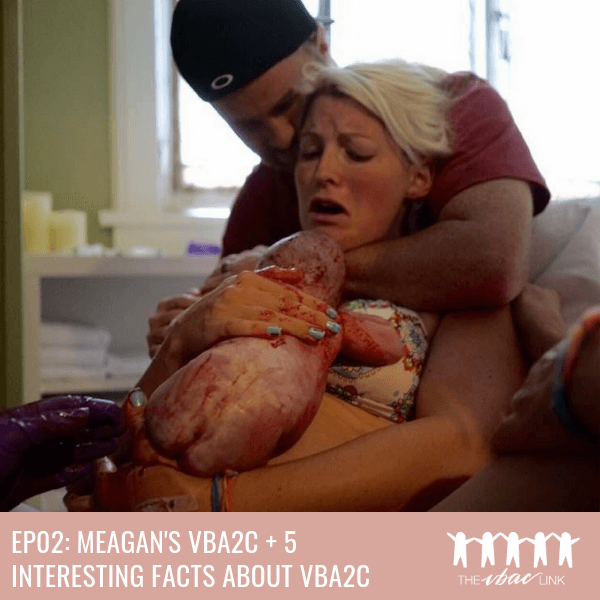
Meagan is the co-founder of The VBAC Link, and boy, does she have a fantastic story about having a Cesarean, a VBAC attempt ending in Cesarean, and finally, a triumphant VBAC story after two Cesareans (VBA2C).
At the end of her first pregnancy, Meagan’s water broke before labor started. As an excited first-time mom, she and her husband rushed to the hospital with anticipation. After laboring with Pitocin and an epidural, Meagan’s doctor told her that she would need a Cesarean because her body wasn’t progressing.
After the Cesarean, Meagan was told by her doctor that her pelvis was too small to birth a baby.
Her second Cesarean was with the same doctor, and she had a TOLAC (trial of labor after Cesarean). Her water broke again, before labor started (PROM). The doctor told Meagan’s husband to “wake up and smell the coffee,” because a VBAC wasn’t going to happen. She was pressured into walking down to the OR for a second Cesarean.
During Meagan’s third pregnancy, she did a lot more research. She ditched her unsupportive provider and found one that looked at her individual needs and would support her desire for a vaginal birth after 2 Cesareans. After feeling not quite right about the new provider, she switched again, this time transferring to a CNM (certified nurse midwife) at a birth center.
Her water broke before labor started for the third time. It took patience, a supportive partner, and an excellent midwife and doula team, but after two days of hard work and a couple of big pushes, her VBA2C baby boy was born!
Listen to Meagan’s full VBA2C Story on Episode 2 of the podcast:
Episode 02: Meagan’s VBA2C + 5 Interesting Facts About VBA2C
Julie’s Home Birth After Cesarean VBAC Stories
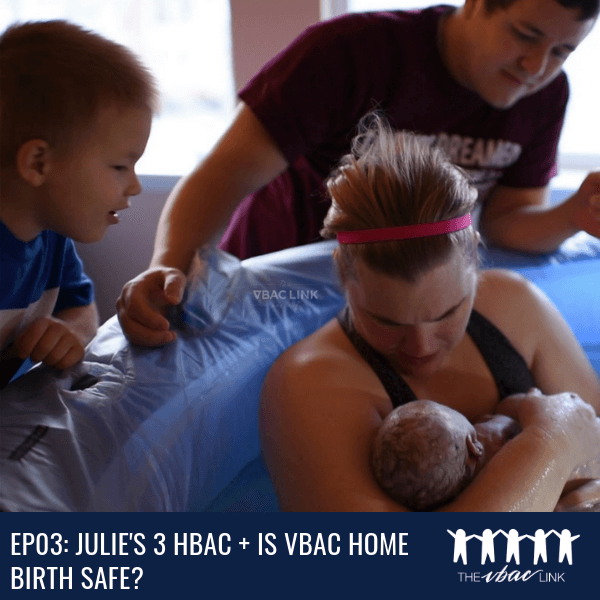
I love sharing my own VBAC stories. I had one Cesarean, then three vaginal births at home with a midwife. You can learn more about home birth after Cesarean (HBAC) here.
I took a hypnobirthing class with my first baby, and planned on going unmedicated. I thought I knew everything. It turns out, I was missing a lot! I was working 50 hours a week at my job and ended up with preeclampsia in my third trimester. I was induced the day before my pregnancy reached 36 weeks, and needless to say, my plans for a beautiful, empowering hypnobirth were gone.
Later, I found out that my doctor was known as “The Quilter” by nursing staff, because of how many Cesareans he did and how beautiful his stitching was.
I didn’t know VBAC was such a controversial subject until my second pregnancy. I learned much more along the way that would help me improve my chances of a successful VBAC. I hired a doula experienced in VBAC, and interviewed multiple providers before I transferred care to a local midwife.
The week I gave birth to my second child, my husband’s grandmother passed away, so we traveled hours to a funeral. His sister was also getting married that week, so we traveled even more.
It turns out I was in early labor at the wedding dinner and had my first VBAC while she was getting married. My VBAC labor was textbook, and having the right provider, doula, and preparation with my husband was vital to having a safe and empowering birth for me.
A wedding, a funeral, and a birth all in a matter of days — it is such a fun story!
To hear all the details of my three homebirth VBAC stories, listen to Episode 3 of the podcast:
Episode 03: Julie’s 3 HBAC + Birth Location Options
Grace’s Breech VBAC After Two Cesareans

We first learned about Grace when she sent us an Instagram message, letting us know she had talked about The VBAC Link with her husband Rico on their podcast, All in with the Allen’s. She had just finished taking our VBAC Prep Course for Parents.
Grace had two previous Cesareans and was preparing for a VBA2C — and her baby was breech. We quickly fell in love with her and knew we had to share her VBAC story once she had her baby.
Grace’s first birth was a Cesarean because her baby had flipped into a breech position two weeks before the due date. Her second birth was also a Cesarean because she didn’t have a VBAC supportive provider and she wasn’t aware of any other options.
With Grace’s third pregnancy, she had to search for a VBA2C supportive provider and do a lot of research. She educated herself on VBAC, including taking our How to VBAC Parent’s Course and finding a supportive provider at 27 weeks.
At 30 weeks, Grace found out her baby was breech. A few days later, the COVID pandemic hit, and all her appointments were online until 36 weeks. She tried every available method to turn a breech baby in those six weeks, but her baby just wouldn’t budge.
Luckily, her provider was willing to deliver a breech baby vaginally, and she did!
Now, she has come full circle and is inspiring women through The VBAC Link by sharing her journey with you. I love the end of her story on the podcast, where we talk about her coming full circle in birth, and as a football wife, the similarities still give me goosebumps.
Listen to Grace discussing her breech VBAC story after two Cesareans on Episode 128:
Episode 128: Grace’s Breech VBA2C
Renay’s Hospital VBAC Success Story
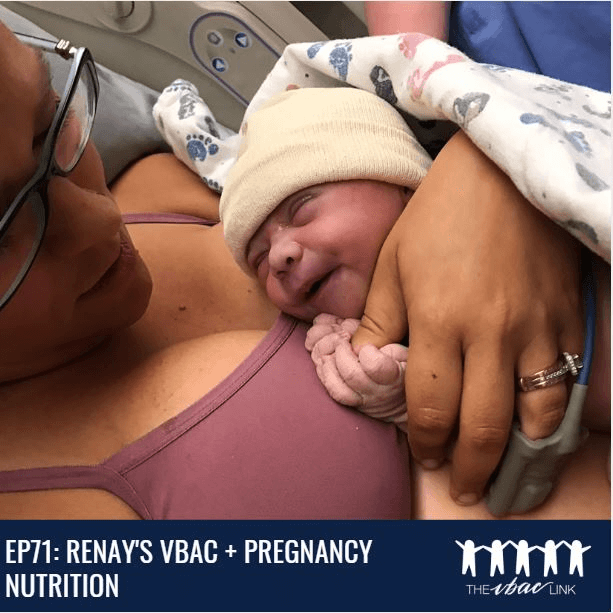
Renay is a powerhouse and a strong example of grit and determination. After 58 hours, she was labeled failure to progress in labor. Her first birth was a Cesarean, leaving her feeling defeated and exhausted. Recovery was difficult, and she was determined to make her next pregnancy and birth better than the first.
Renay had some major health issues to work through. Over the next three years, she made drastic changes in her physical and mental health. She entered her second pregnancy much healthier, both physically and mentally.
After announcing her pregnancy, Renay hired a VBAC-experienced doula. One of the benefits of having a doula is their ability to connect you with quality information and resources in the birth community. Renay’s doula recommended taking our How to VBAC Parent’s Course. She was one of our first students, and we fell in love with her and her family.
After a very eventful pregnancy, it was finally time for her baby boy to be born. It was a long labor again, lasting three days. But, with support from her doula, care provider, and hospital, everyone involved had the patience they needed for Renay to achieve her VBAC.
She went into the birth determined to have all the benefits of a natural birth. After laboring for three days, she was utterly exhausted and asked for an epidural. Rather than negatively affecting her plans, having an epidural during the VBAC allowed Renay to rest and prepare for birth. After some rest and a light lunch, she was ready to meet her baby!
Meagan and I were on the edge of our seats, waiting to hear the news. We were together when Renay’s doula texted us, and we screamed and jumped for joy! This story is entertaining and educational, and we are sure you will love it just as much as I do.
Hear all of Renay’s VBAC story on Episode 89 of the podcast:
Episode 89: Renay’s VBAC + Pregnancy Nutrition
Elyssa’s Repeat Cesarean After a TOLAC Story During a Pandemic
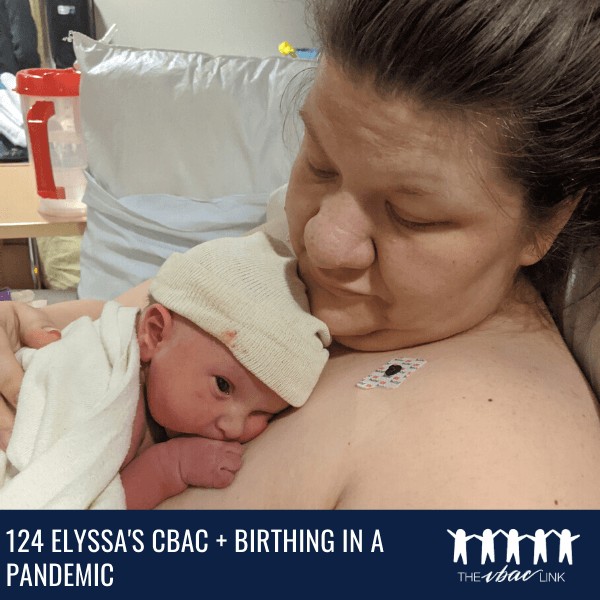
Elyssa is a client of my doula practice, so her story is very near and dear to my heart. During her first pregnancy, she had severe preeclampsia, which resulted in an emergency Cesarean at 34 weeks pregnant. Her baby spent some time in the NICU, but came out with no lingering issues.
The birth plan for her second birth? For the baby to come out the right hole.
Sometimes, plans need to change. Childbirth is unexpected, and as Anna says in Frozen II, when you cannot see the future, you just need to “do the next right thing.” That’s precisely what Elyssa did all through her pregnancy and birth.
Elyssa changed providers three times. One of those times was during her induction at 37 weeks due to high blood pressure. She had Pitocin going and everything; she had been told that her doula could be with her during labor, but then policies changed due to the COVID pandemic. Her provider fought hard for her, but the administration wouldn’t budge. Elyssa’s provider contacted midwives at a hospital that was allowing doulas, and coordinated her transfer. She walked out with the IV line still in her arm and walked into a supportive environment.
Elyssa labored for two days, and during her labor, she quickly and suddenly developed severe preeclampsia again. With her husband, she decided that it was time for her son to arrive. Since she was still at 4 cm dilated, they discussed options with their care team. They agreed that a Cesarean was necessary for both mother and baby’s safety.
We’ve written more about how to cope with a “failed” VBAC, but there is no failing in birth — just plans that sometimes have to change. Mourning the loss of a birth experience you fought hard for and being happy that you have a new baby are two feelings that can exist in the same space in a very complicated way.
Listen to Elyssa’s incredible story of having an unplanned C-section during a pandemic:
Episode 124: Elyssa’s CBAC + Birthing in a Pandemic
Shannon’s VBA3C Story: Vaginal Birth After Multiple Cesareans
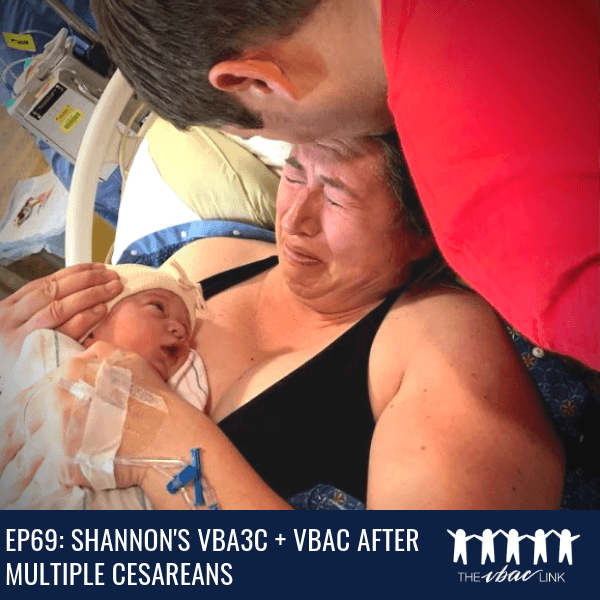
Shannon, another client of mine, had 3 Cesareans before she decided she wanted to try for a VBAC. Many parents don’t have the option to attempt a VBAC after just one Cesarean, and finding a provider to support a VBAC after 3 C-sections can be tricky.
Shannon switched providers to a well-known OBGYN in Utah that supports VBAMC. Her first was a C-section for a suspected big baby, and her second was for a breech baby. For her third birth, she didn’t think she had any other options, so she had a scheduled Cesarean.
Everyone assumed that her fourth baby would be large, but she declined a third-trimester growth scan to avoid any pressure to deliver sooner than her body was ready.
Her provider recommended induction at 41 weeks and told her that he doubted she would deliver vaginally as time passed. Shannon weighed her provider’s advice, checked her pregnancy intuition, discussed options with her birth team, and declined being induced.
By the time she hit 41 weeks and five days of pregnancy, she felt it was time to induce. Her provider supported her decisions all along the way, even through times he recommended otherwise.
Shannon’s labor was two days long, with slow but steady progress. She decided to get an epidural so she could get some much-needed rest. After not progressing for a few hours, she decided she would ask for a Cesarean if the next cervical check was the same.
After a nap, she woke up and was eight centimeters dilated! Everyone in the room shouted for joy as she quickly progressed to 10 cm and pushed her baby out in just two more hours, achieving her goal of vaginal birth after 3 Cesareans!
Catch all the suspenseful details of Shannon’s VBAC story on Episode 86 of the podcast:
Episode 86: Shannon’s VBA3C + Vaginal Birth After Multiple Cesareans
Katie’s VBAC Car Birth Story
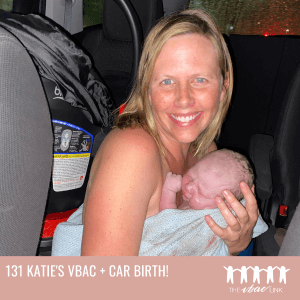
I was SO excited when I heard Katie had a baby in the car, on her way to the hospital. I always say that that is my dream birth, so I just HAD to have her share all the details with us. Her first baby was born vaginally with an epidural under midwifery care at a hospital.
She wanted a different experience for her second birth and chose to receive care and deliver her baby at a birth center. She labored all the way to the pushing stage and pushed for four hours. She and her team decided a transfer to the hospital would be best at that point. They determined a Cesarean was necessary at the hospital, and that is how she welcomed her second baby into the world.
As Katie prepared for her third birth, a VBAC, the COVID-19 pandemic hit the world fast and furious. She chose to give birth at the hospital this time, and when labor started, nobody could predict what would happen. As the intensity picked up, and her water broke, they decided to head to the hospital. Once on the way, labor progressed quickly, and she delivered her baby in the car on the side of the road. Just Katie and her husband were there.
The birth was unexpected and unplanned, but she describes it as a very peaceful and empowering experience. She was welcomed at the hospital by a very caring staff and was blown away by the care she received, even during the pandemic.
Katie’s VBAC story will have you on the edge of your seat! Give it a listen on Episode 131:
Episode 131: Katie’s VBAC + Car Birth!
Kimberly’s 2 VBAC Stories (after 4 Cesareans), and a Rainbow Baby After VBAC Induction
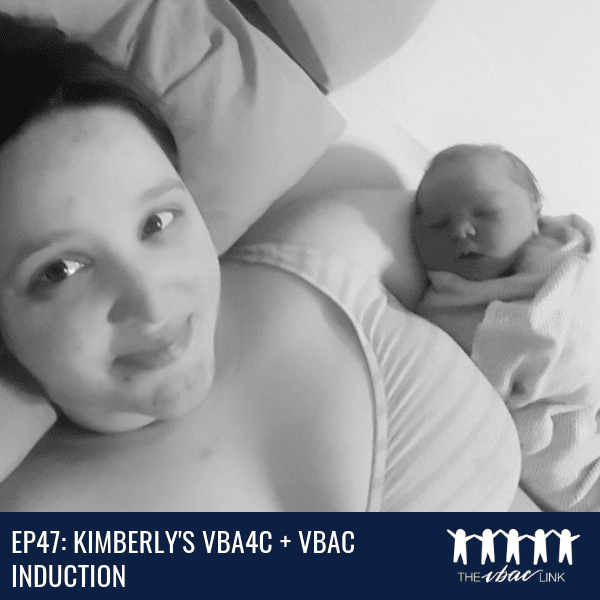
Kimberly’s VBAC stories (2 vaginal births after 4 Cesareans) will have you laughing and crying, mourning and motivated, shocked and surprised. There are so many moving parts of her journey; there is something for everyone in these birth stories!
Kimberly’s first birth was a Cesarean after a failed induction at 39 weeks. She was young, married to a military man, and admittedly not very educated about birth. In 12 hours, she dilated to four centimeters, and her provider pressured her into a Cesarean. She suffered postpartum depression as her military family moved across the country.
Her second was an empowering VBAC experience. She got to the hospital five centimeters dilated, and 6 hours later, Kimberly had a beautiful VBAC baby in her arms.
The third birth was another Cesarean. This birth was an induction, and her baby wasn’t tolerating Pitocin contractions well. She was given a spinal and had a better experience than her first Cesarean, but was still disappointed in having another one.
For Kimberly’s fourth birth, she had moved across the state and her new provider “doesn’t do” VBA2C. She interviewed provider after provider and was lied to about uterine rupture rates. No one would give her a chance, even though she had a “proven pelvis” with a previous vaginal birth. She felt discouraged, and scheduled a repeat Cesarean due to a lack of support.
Her fifth pregnancy was a surprise when her previous baby was just seven months old. Her husband was now out of the military, and they made another move across the country. She found a midwife to support her in a VBA3C. As she approached 42 weeks, she noticed the baby was not moving, so she rushed to the hospital. The ultrasound showed that the baby had passed. This hospital they were at had a VBAC ban, and they had another Cesarean.
They knew they still wanted another baby, and Kimberly’s sixth pregnancy was full of anxiety and fear. At 28 weeks, she found a provider 3 hours away, who she describes as a “midwife in scrubs.” He was known for his support of VBAMC. They chose to induce at 38 weeks for her peace of mind.
They started a low dose of Pitocin and ended with another vaginal birth. A VBA4C!
Listen to Kimberly’s tear-jerking, yet empowering VBAC story:
Episode 57: Kimberly’s VBA4C + VBAC Induction
Schermisia’s VBAC Story: Black Women & VBAC
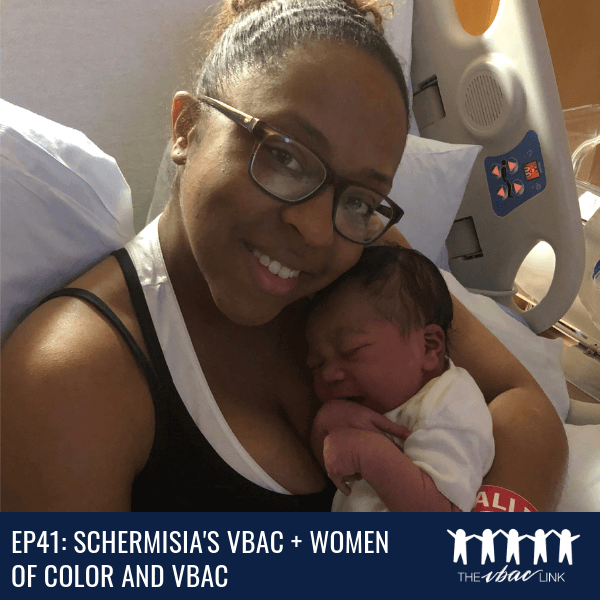
I found Schermisia by stalking hashtags about women of color + VBAC on Instagram. Yes, I was that desperate to VBAC stories from Black and Hispanic parents. If you do not know why, let me explain. Women of color, especially Black women, have significantly higher chances of having Cesareans, considerably lower chances of having a VBAC, and are two to three times more likely to die during childbirth.
There is an inherent racial disparity in our maternal care system, and we MUST talk about it. Awareness is the first step to finding solutions. Find out more information on Black maternal health at the website Black Mamas Matter.
During Schermisia’s first pregnancy, she was so swollen she couldn’t even tie her shoes. She was struggling, and no one seemed to take her concerns seriously, even after switching providers and transferring to midwifery care. When her water broke three days before her due date, since she was GBS+, they rushed to the hospital to start treatment for Group B strep prevention.
It turns out, she had very high blood pressure and was dilated to one centimeter. She labored all day on Pitocin, and only dilated to 2 cm when the provider told her she needed a Cesarean. Less than two weeks later, she went right back into the hospital with an infection in her incision site. It wasn’t until she was readmitted that she discovered she had preeclampsia, and no one had ever told her.
Three years later, she found herself pregnant again. She wanted a VBAC vs. a repeat Cesarean, but everybody argued against her.
Schermisia fought HARD for her VBAC against an unsupportive provider, a less than supportive hospital, and even friends and family who didn’t believe VBAC is a safe option. Her strength and determination are inspiring, and you will be cheering her on as you listen to her story.
You can listen to Schermisia’s VBAC story in Episode 49:
Episode 49: Schermisia’s VBAC + Women of Color
Heather’s Uterine Rupture Story During Trial of Labor After Cesarean
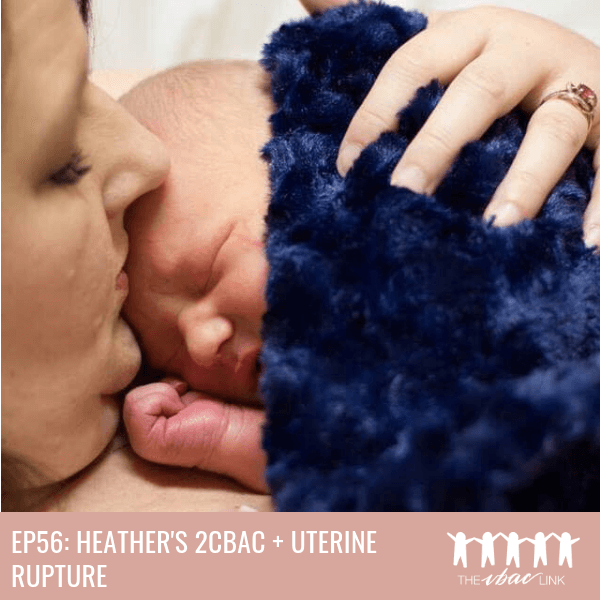
Heather had a uterine rupture during a TOLAC (Trial of Labor After Cesarean) after two Cesareans. While uterine rupture is rare, it does happen, and we want you to hear from parents who have been through it. By hearing these stories, you can learn from their experience and educate yourself about the signs of rupture.
Heather had planned C-sections for her first two pregnancies, but with her third and last baby, she wanted a vaginal birth. She has Type II diabetes and was monitored closely during her pregnancy. She went in for her induction, and they started Pitocin as she labored in the water. During the end of her pregnancy, she had sharp pains on and off on her left side and had one again as she was getting out of the water.
Heather received an epidural soon after, and the birth team decided to break her water. She got to eight centimeters dilated, and the baby’s heart rate started to struggle. While they were changing Heather’s position, they realized that the baby was posterior (sunny side up). The doctor manually turned the baby into a better position (an internal version).
When they turned the baby, she felt a sharp pain. It felt like a “zipper was unzipping in her belly,” and a hot knife was placed there. Keep in mind, she felt this even with an epidural in place.
The baby’s heart dropped off the monitor, and the birth team did a splash and go Cesarean, putting Heather under general anesthesia to get the baby out in just a few seconds. Her provider said it was the worst rupture she had ever seen. The interesting thing is that her rupture was vertical to her uterus, when her Cesarean scar was horizontal.
Luckily, Heather and her baby are healthy and well, but they both faced a difficult recovery.
You will fall in love with Heather’s Tennessee accent as you listen to her share her three birth stories:
Episode 68: Heather’s 2CBAC + Uterine Rupture
Trigger warning: There is some graphic detail as she describes the traumatic birth experience on the podcast.
Leslie’s Homebirth VBAC with a Special Scar Story

Leslie and I went to high school together, had our Cesarean births around the same time, and had VBACs just a month apart. Her story is unique because her Cesarean delivery left her with an inverted T scar on her uterus, one of the four special scars.
As a physician assistant that had worked in the maternity unit before, Leslie’s first labor and delivery left her feeling frustrated and angry. She felt that the system had set her up for failure. Having a special scar adds a layer of difficulty in finding a VBAC-supportive provider, due to a slight increase in the likelihood of uterine rupture.
The one provider in Leslie’s area known for supporting unique VBAC situations told her she was a “ticking time bomb” just waiting to rupture.
Leslie found a midwife to support her through her pregnancy and birth, and is well educated on the risks associated with her scar type. She was prepared to handle things in the case of an emergency.
Labor hit Leslie hard and fast. She was at home and settling in for the night when contractions started. Labor almost immediately dropped her to her knees, as her husband rushed to set up the birth tub, call the birth team, and help make Leslie comfortable laboring at home.
On her way to use the bathroom, Leslie dropped to her hands and knees and knew she wasn’t going to make it. Everything just felt like a huge whirlwind. Her midwife walked in the door just as Leslie started pushing, and after just a few pushes, her VBAC baby was born!
Leslie’s knowledge and thoughts on birth and VBAC will leave you feeling more educated and inspired to make confident decisions regarding your pregnancy and childbirth.
Listen to Leslie’s incredible VBAC story on the podcast, Episode 18:
Episode 18: Leslie’s HBAC + Special Scars
Want to learn everything you can to plan for your own VBAC Story?
Register today for our Ultimate VBAC Course for Parents, where we dig into the stats, facts, and details and provide you with all the preparation you need to make your VBAC plans.

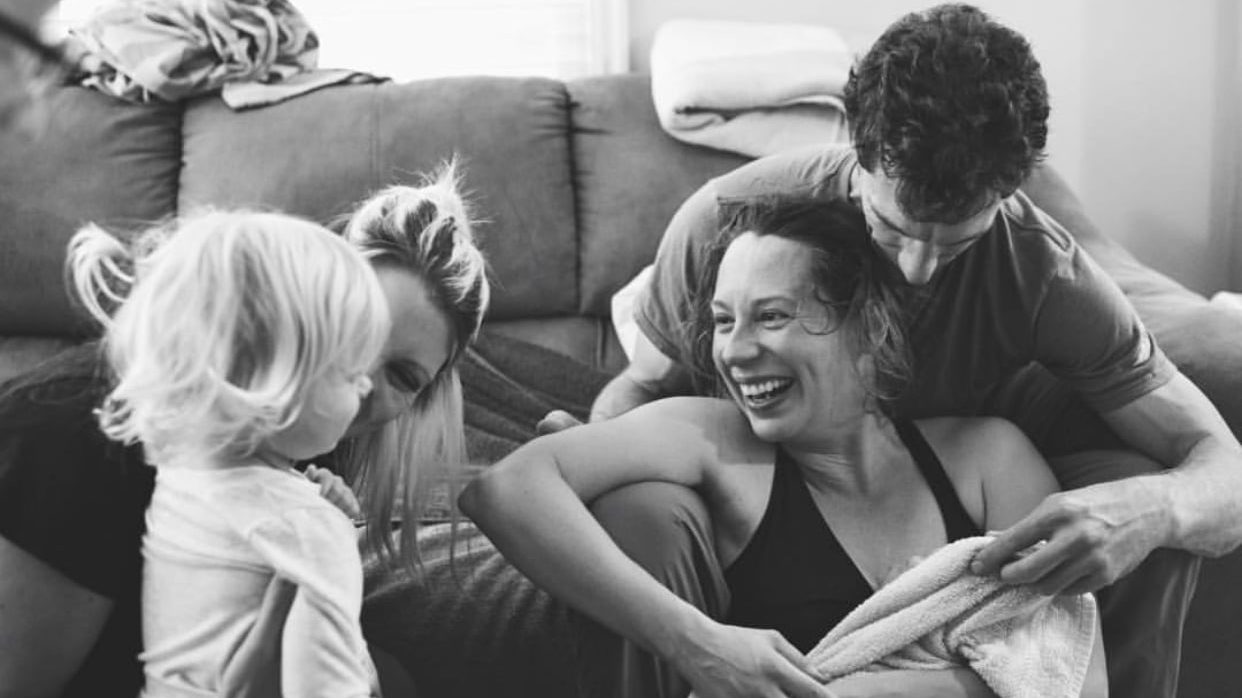












 VBAC & Epidural: Safety and C-Section Risk Explained
VBAC & Epidural: Safety and C-Section Risk Explained
Thanks for sharing these stories. I have had two c sections and am now pregnant with my third baby. I am hoping and praying for a VBAC this time.
We are rooting for you! Remember, you are amazing!!! Please keep in touch! And be sure to check out our How to VBAC Prep Course!
I’m 35 weeks with my 5th baby and trying to decide how much to push for a vbac. My 4th baby was my only C-section due to transverse lie. Because of his position I have an inverted T. They want to schedule me for a C-section at 37 weeks and in order to even to tolac I’d have to go AMA. It’s so hard to know what to do. I also have needed pitocin in the past and that is not an option this time plus this one is still transverse lie as well, although I know that can change. It feels like things are stacked against me and time is ticking closer and closer.
Hi Jess!! First of all, remember this — your intuition about what is possible in birth is your most powerful tool! After that, build your supportive team and educate yourself! If you haven’t already, I think you’d love our course for parents because it’s full of stats, info and more to inform and empower your VBAC journey, helping you make choices that are right for YOU! Shoot us an email at info@thevbaclink.com for a code to get 30% off enrollment this week! Sending you love!! 💙